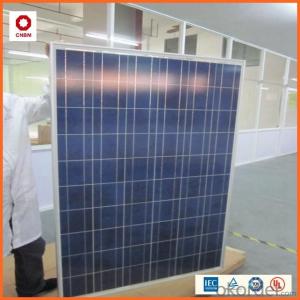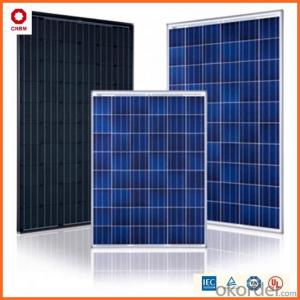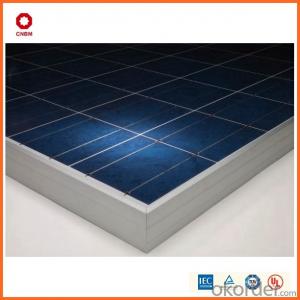45w Small Solar Panels with Good Quality
- Loading Port:
- China main port
- Payment Terms:
- TT OR LC
- Min Order Qty:
- 1 watt
- Supply Capability:
- 10000000 watt/month
OKorder Service Pledge
OKorder Financial Service
You Might Also Like
Item specifice
Hot Sale !!! Quality and Safety of Small Poly Solar Panel 25~85w
1. Rigorous quality control meets the highest international standards.
2. High-transmissivity low-iron tempered glass, strong aluminium frame.
3. Using UV-resistant silicon.
4. IS09001/14001/CE/TUV/UL
Warranties of Small Poly Solar Panel 25~85w
1. 10 years limited product warranty
2. 15 years at 90% of the minimal rated power output
3. 25 years at 80% of the minimal rated power output
Specification
Characteristics of Poly solar panels CNBM (25-85W) | |||||
Max Power Voltage Vmp(V) | 30.3 | 30.8 | 31.1 | 31.4 | 31.85 |
Max Power Current Imp(A) | 7.60 | 7.64 | 7.73 | 7.81 | 7.85 |
Open Circuit Voltage Voc(V) | 36.1 | 36.6 | 37 | 37.3 | 37.68 |
Short Circuit Current Isc(A) | 8.50 | 8.55 | 8.65 | 8.75 | 8.85 |
Max Power Pm(W) | 230W | 235W | 240W | 245W | 250W |
Temperature Coefficient of Cells Poly solar panels CNBM (25-85W) | |
NOCT | 45± 2 |
Temperature Coeffucients of Isc | 0.0492 |
Temperature Coeffucients of Voc | -0.3374 |
Temperature Coeffucients of Voc | -0.4677 |
Mechanical Data of Poly solar panels CNBM (25-85W) | |
Dimension | 1638 × 982 × 40 mm |
Weight | 19.5 kg |
No. of Cells and Connections | 60 (6 ×10) |
Tolerance | 0 ~ + 5 W |
Cell | Monocrystalline Cell 156 × 156 mm |
Packing | 624 Pcs/40ft(H) Container |
Limits of Poly solar panels CNBM (25-85W) | |
Operating Temperature | -40 to +85 |
Storage Temperature | -40 to +85 |
Max System Voltage | 1000VDC(IEC) / 600VDC(UL) |
Features of our products:
• High conversion efficiency mono/poly-crystalline amorphous silicon solar cells
• Modules incorporate high performance bypass diodes to minimize the power drop caused by shading
• High transmittance, low-iron tempered glass
• High performance EVA encapsulant to prevent destroying and water.
• AI frame: without screw, corner connection. 8 holes on the frame can be installed easily
• Good performance of preventing from atrocious weather such as wind and hails
• Certifications: CE IEC TUV VDE UL, Class I
• 10 years 90% power output warranty

Shipping of Small Poly Solar Panel 25~85w
By Sea | Delivery from Shanghai or Ningbo seaport |
By Air | Departure from Shanghai Pudong Airport |
By Express | Post by DHL, EMS, UPS, TNT. |
- Q:What are the different types of solar panels used in solar energy systems?
- The different types of solar panels used in solar energy systems include monocrystalline, polycrystalline, thin-film, and bifacial panels. Monocrystalline panels are made from a single crystal structure, making them highly efficient but more expensive. Polycrystalline panels are made from multiple crystal structures, offering a lower cost but slightly lower efficiency. Thin-film panels use layers of semiconductor materials and are flexible, lightweight, and less efficient. Bifacial panels can absorb sunlight from both sides, increasing their overall energy generation.
- Q:Can solar energy systems be used for powering airports?
- Yes, solar energy systems can be used for powering airports. Solar panels can be installed on the roofs of airport buildings or on nearby ground areas to generate electricity. This renewable energy source can help reduce the carbon footprint of airports and provide a sustainable power solution. Additionally, solar energy systems can also be used to power auxiliary equipment such as runway lights and navigation aids, making airports more energy-efficient.
- Q:What are the advantages of using solar energy?
- There are several advantages of using solar energy. Firstly, it is a renewable source of energy, meaning that it can be continuously replenished and will never run out. This makes it a sustainable and environmentally friendly option. Secondly, solar energy helps to reduce greenhouse gas emissions and combat climate change, as it does not produce any harmful pollutants during operation. Additionally, solar energy systems are relatively low-maintenance and have long lifespans, resulting in reduced operational costs. Moreover, solar energy can be harnessed in remote areas where traditional electricity sources are not accessible, providing power to underserved communities. Lastly, installing solar panels on residential or commercial buildings can lead to significant savings on electricity bills. Overall, the advantages of using solar energy include sustainability, environmental benefits, cost savings, and increased energy accessibility.
- Q:Can solar energy systems be used in areas with limited access to the electrical grid?
- Yes, solar energy systems can definitely be used in areas with limited access to the electrical grid. In fact, solar power is an ideal solution for such areas as it offers a decentralized and sustainable source of electricity. Solar energy systems, such as photovoltaic panels, harness the energy from the sun and convert it into usable electricity. These systems can be installed in remote locations without the need for extensive electrical infrastructure. By utilizing solar energy systems, areas with limited access to the electrical grid can become self-sufficient in meeting their energy needs. These systems can power essential appliances, such as lighting, communication devices, and small-scale machinery, providing reliable energy even in areas where traditional grid connections are not available or unreliable. Moreover, solar energy systems can bring numerous benefits to areas with limited grid access. They offer an environmentally friendly alternative to traditional fossil fuel-dependent energy sources, thereby reducing carbon emissions and combating climate change. Solar power systems also provide a reliable and consistent source of energy, reducing the dependence on diesel generators or other costly and polluting forms of energy. Additionally, solar energy can promote economic growth and development in remote areas. By powering essential infrastructure like schools, hospitals, and businesses, solar systems can improve education, healthcare, and economic opportunities. Moreover, the installation and maintenance of solar energy systems can create local jobs and foster entrepreneurship. To ensure the successful implementation of solar energy systems in areas with limited grid access, it is crucial to address challenges such as initial costs, technical expertise, and maintenance. However, with advancements in technology and decreasing costs, solar power has become increasingly accessible and affordable. Various organizations, governments, and non-profit entities are actively working to promote solar energy adoption in such areas and provide necessary assistance. In conclusion, solar energy systems are a viable and sustainable solution for areas with limited access to the electrical grid. They offer a decentralized, reliable, and environmentally friendly source of electricity, bringing numerous benefits to these regions. By harnessing the power of the sun, these systems can empower communities, promote economic development, and improve the quality of life for those living in remote areas.
- Q:Can solar energy systems be used for powering water pumping systems?
- Yes, solar energy systems can be used to power water pumping systems. Solar-powered water pumping systems utilize photovoltaic panels to convert sunlight into electricity, which can then be used to power water pumps. These systems are cost-effective, environmentally friendly, and have proven to be reliable in remote areas where grid electricity is not available.
- Q:What is the lifespan of solar batteries used in solar energy systems?
- The lifespan of solar batteries used in solar energy systems can vary depending on several factors such as the type of battery, usage patterns, and maintenance. Generally, most solar batteries are designed to last between 5 to 15 years, but some high-quality batteries can last up to 20 years or more with proper care. It's important to note that over time, the battery's capacity may degrade, reducing its ability to store and provide energy efficiently. Regular monitoring and maintenance can help extend the lifespan of solar batteries.
- Q:Can solar energy systems be used in powering movie theaters or entertainment venues?
- Yes, solar energy systems can definitely be used to power movie theaters or entertainment venues. Movie theaters and entertainment venues require a significant amount of electricity to operate their lighting, sound systems, projectors, and other equipment. Solar energy systems can generate clean and renewable electricity by harnessing the power of the sun. By installing solar panels on the roofs or surrounding areas of these venues, they can generate a substantial amount of electricity to meet their energy needs. Solar energy systems can be designed to provide enough power to not only run the basic infrastructure of movie theaters or entertainment venues but also to support additional energy-intensive features such as heating, ventilation, and air conditioning (HVAC) systems, concession stands, and even electric vehicle charging stations. By utilizing solar energy, these venues can significantly reduce their reliance on grid electricity, lower their operational costs, and contribute to a more sustainable and eco-friendly future. In addition to the practical benefits, installing solar energy systems in movie theaters or entertainment venues can also serve as a statement of environmental responsibility and attract environmentally conscious audiences. Many people are becoming increasingly aware of the importance of renewable energy, and by showcasing their commitment to sustainability, these venues can enhance their brand image and appeal to a broader customer base. Overall, the utilization of solar energy systems in powering movie theaters or entertainment venues is not only technically feasible but also financially and environmentally advantageous. By harnessing the power of the sun, these venues can reduce their carbon footprint, save on energy costs, and contribute to a greener future for the entertainment industry.
- Q:Are there any disadvantages or limitations to using solar energy systems?
- Yes, there are a few disadvantages and limitations to using solar energy systems. Firstly, solar panels require a significant initial investment, making the upfront costs relatively high. Additionally, the efficiency of solar panels is dependent on factors such as weather conditions and geographic location, which may impact their energy production. Solar energy is also intermittent, meaning it cannot be generated during nighttime or cloudy days, requiring the use of energy storage systems or alternative power sources. Finally, the manufacturing and disposal of solar panels can have environmental impacts, although these are generally outweighed by the long-term benefits of using solar energy.
- Q:Can solar energy systems be used in areas with high levels of light pollution?
- Yes, solar energy systems can still be used in areas with high levels of light pollution. While light pollution can reduce the efficiency of solar panels by obstructing direct sunlight, solar energy systems can still generate electricity even in less ideal conditions. It is important to note that the overall performance of the system may be affected, but advancements in solar technology and proper positioning of panels can help mitigate the impact of light pollution on solar energy generation.
- Q:How do solar energy systems connect to the electrical grid?
- Solar energy systems can connect to the electrical grid by means of net metering, a process that enables the system to generate and consume electricity from the grid. Excess power generated by the solar energy system is sent back to the grid and measured by a bi-directional meter, which calculates the flow of electricity in both directions. This surplus electricity is then credited to the system owner's account, effectively reversing the meter. Conversely, during times when the solar energy system is unable to meet the electricity demand, such as at night or on cloudy days, electricity is drawn from the grid to make up for the shortfall. The bi-directional meter accurately records this flow of electricity and measures the amount consumed from the grid. In summary, the connection between solar energy systems and the electrical grid facilitates the seamless integration of renewable energy into the existing power infrastructure. Net metering ensures that solar system owners can contribute excess electricity to the grid and draw from it when needed, resulting in a more efficient, reliable, and sustainable energy system.
1. Manufacturer Overview |
|
|---|---|
| Location | |
| Year Established | |
| Annual Output Value | |
| Main Markets | |
| Company Certifications | |
2. Manufacturer Certificates |
|
|---|---|
| a) Certification Name | |
| Range | |
| Reference | |
| Validity Period | |
3. Manufacturer Capability |
|
|---|---|
| a)Trade Capacity | |
| Nearest Port | |
| Export Percentage | |
| No.of Employees in Trade Department | |
| Language Spoken: | |
| b)Factory Information | |
| Factory Size: | |
| No. of Production Lines | |
| Contract Manufacturing | |
| Product Price Range | |
Send your message to us
45w Small Solar Panels with Good Quality
- Loading Port:
- China main port
- Payment Terms:
- TT OR LC
- Min Order Qty:
- 1 watt
- Supply Capability:
- 10000000 watt/month
OKorder Service Pledge
OKorder Financial Service
Similar products
New products
Hot products
Hot Searches
Related keywords































